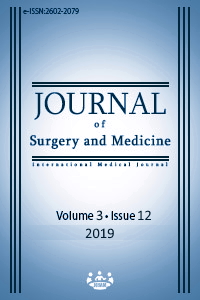Pneumoperitoneum in laparoscopic surgery: Comparison of the effect on gastric and intestinal motility in pediatric and adult rats
Keywords:
Laparoscopy, Pneumoperitoneum, Gastric motility, Intestinal motility, ChildAbstract
Aim: There are limited data on how pneumoperitoneum used during laparoscopy affects gastric and intestinal motility in children compared to adults. The aim of this experimental study is to measure and compare the effects of pneumoperitoneum on the gastric and small intestinal motility among children and adult rats.
Methods: The study was conducted with 4 groups: Groups 1 and 2 (n=8 and 7, respectively) comprised pediatric rats while Groups 3 and 4 (n= 10 and 10, respectively) included adult rats. Pneumoperitoneum was achieved in Groups 1 and 3. Laparotomy was performed in Groups 2 and 4. The duration of procedure was 90 minutes in all groups. CO2 (Thermoflator, Karl-Storz, Germany) insufflation pressure was maintained at 5 mHg-0.5 ml/min. Postoperative gastric and intestinal motility studies were performed in all groups. Contractile responses to Acetylcholine and potassium chloride (at a dose range of 10-8 to 10-3 mM) were recorded (Isometric Transducer, Biopac, USA). Data Collection Analysis System (MP100 Biopac, USA) was used to analyze the data.
Results: The lowest contraction response was obtained in group 1 for both the stomach and intestine. The responses of pediatric groups to potassium chloride and acetylcholine were lower than those of adult groups, but there was no significant difference among the 4 groups (P>0.05).
Conclusion: This study may suggest that in the similar setting for pediatric and adult age groups, pneumoperitoneum does not significantly adversely affect gastric and small intestinal motility in children. Future studies should aim to investigate the effects of pneumoperitoneum on gastric and intestinal motility at different ages, weights, types of anesthesia, intra-abdominal pressures and operative durations.
Downloads
References
Jimbo T, Masumoto K, Takayasu H, Shinkai T, Urita Y, Uesugi T, et al. Outcome of early discharge protocol after appendectomy for pediatric acute appendicitis. Pediatr Int. 2017;59(7):803-6.
Ünsal A.M, İmamoğlu M, Kadioğlu M. The Acute Alterations in Biochemistry, morphology and contractility of rat-isolated terminal ileum via increased intra-abdominal pressure. Pharmacological Research. 2006;53:135-41.
Goitein D, Papasavas P, Yeaney W, Gaqne D, Hayetian F, Caushaj P, et al. Microsphere intestinal blood flow analysis during pneumoperitoneum using carbon dioxide and helium. Surg Endosc. 2005;19:541-5.
Diebel LN, Dulchavsky SA, Brown WJ. Splanchnic ischemia and bacterial translocation in the abdominal compartment syndrome. J Trauma. 1997;43:852-5.
Samel ST, Neufang T, Mueller A, Leister I, Becker H. New abdominal cavity champer to study the impact of increased intraabdominal pressure on microcirculation of gut mucosa by using video microscopy in rats. Crit Care Med. 2002;30:1854-8.
Ludwig KA, Frantzides CT, Carlson MA, Grade KL. Myoelectric motility patterns following open versus laparoscopic cholecystectomy. J Laparoendosc Surg. 1993;3:461-6.
Naito T, Garcia-Luiz A, Vladisavljevic A, Matsuno S, Gagner M. Gastrointestinal transit and stress response after laparoscopic vs conventional distal pancreatectomy in the canin model. Surg Endosc. 2002;16:1627-30.
Hotokezaka M, Dix J, Mentis EP, Schirmer BD. Gastrointestinal recovery after laparoscopic vs open colon surgery. Surg Endosc. 1996;10:485-9.
Sparkes AH, Papasouliotis K, Viner J, Cripps PJ, Gruffydd-Jones TJ. Assessment of orocaecal transit time in cats by the breath hydrogen method: the effects of sedation and a comparison of definitions. Res Vet Sci. 1996;60:243-6.
Inada T, Asai T, Yamada M, Shingu K. Propofol and midazolam inhibit gastric emptying and gastrointestinal transit in mice. Anesth Analg. 2004;99(4):1102-6.
Taché Y, Martinez V, Million M, Wang L. Stress and the gastrointestinal tract III. Stress-related alterations of gut motor function: role of brain corticotropin-releasing factor receptors. Am J Physiol Gastrointest Liver Physiol. 2001;280(2):173-7.
Caso JR, Leza JC, Menchén L. The effects of physical and psychological stress on the gastro-intestinal tract: lessons from animal models. Curr Mol Med. 2008;8(4):299-312.
Mayer S, Peukert N, Gnatzy R, Gosemann JH, Lacher M, Suttkus A. Physiologic Changes in a Small Animal Model for Neonatal Minimally Invasive Surgery. J Laparoendosc Adv Surg Tech A. 2018;28(7):912-7.
Downloads
- 689 1064
Published
Issue
Section
How to Cite
License
Copyright (c) 2019 Umut Alıcı, Ahmet Unlu, Yasemin Aydın, Baran Tokar
This work is licensed under a Creative Commons Attribution-NonCommercial-NoDerivatives 4.0 International License.
















